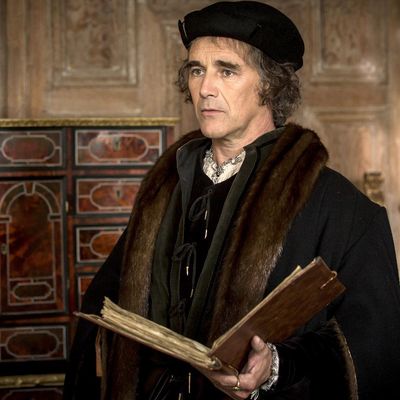
Rejoice — the long-awaited conclusion to a best-selling series of popular fiction based on late-medieval British history is here! I am of course talking about The Mirror and the Light, Hilary Mantel’s follow-up to 2009’s Wolf Hall and 2012’s Bring Up the Bodies, which has finally arrived after an eight-year wait. Thinking about jumping back into the Tudor pool? Here’s a refresher on everything you need to know before you do:
The books tell the story of Thomas Cromwell, one of Henry VIII’s most trusted advisers.
Most prior fictional treatments of Cromwell depict him as a conniving backstabber, but Mantel’s version is much more sympathetic. Her Cromwell is the self-made son of an abusive drunken blacksmith, who uses his polymathic gifts to attain ever-greater political power, yes, but also to usher in a more meritocratic age. In this, he faces off against a series of upper-class twits who’ve fooled themselves into believing their privileges of birth actually mean something. This Cromwell is a Renaissance man in every meaning of the term; in his mind, we can detect the first stirrings of modernity. As Mantel puts it in one memorable passage from Wolf Hall:
The world is run from Antwerp, from Florence … from Lisbon, where the ships with sails of silk drift west and are burned up in the sun. Not from the castle walls, but from counting houses, not be the call of the bugle, but by the click of the abacus, not by the grate and click of the mechanism of the gun but by the scrape of the pen on the page of the promissory note that pays for the gun and the gunsmith and the powder and shot.
Over the first two books, Cromwell’s talents have a way of making him indispensable, first to Cardinal Thomas Wolsey and then to Henry VIII. His skills include not just finance and accounting but other arts as well: “He can draft a contract, train a falcon, draw a map, stop a street fight, furnish a house and fix a jury.” He’s also an amoral political manipulator who is able to provide what the king wants without ever having to be asked explicitly. Cromwell takes great pains to hide his true motives; his internal motto is “Arrange your face,” a reminder to turn his features into a blank mask closed off to the world.
The first two books covered Cromwell’s slow and steady rise.
Wolf Hall detailed Henry’s quest to throw aside his first marriage because she is unable to give him a son, and take Anne Boleyn as his new wife. Cromwell begins the main narrative as Wolsey’s right-hand man and gets a front-row seat to his downfall after the cardinal proves unable to get the Vatican to sanction Henry’s efforts to end his marriage. He soon becomes enmeshed in Henry’s court, where he spars with his frenemy Anne, “a calculating being, with a cool slick brain at work behind her hungry black eyes.” Learning from the example of Wolsey, Cromwell works tirelessly to aid Henry in his break from the Catholic Church, which he resents for not granting his annulment. It’s a mutually beneficial relationship: Cromwell is not only rewarded with more and more access to the king, the highest possible honor in a royal court, but the reader knows that he’s also harboring secret Protestant sympathies as well. The book climaxes with a show trial of Cromwell’s rival Thomas More, who refused to swear an oath of allegiance to Henry, and the crowning of Anne Boleyn as England’s new queen.
Bring Up the Bodies is a much brisker affair. As Anne proves equally unable to grant the king the son he yearns for, Henry’s attentions drift elsewhere, and it becomes clear that this queen too will have to be disposed of. The book builds to another show trial masterminded by Cromwell, this time of Anne and her accused lovers, a gaggle of young men who had the bad luck to have been spotted mocking Wolsey back in book one. Having now rid Henry of two wives and, in the process, eliminated many of his rivals for the king’s ear, Cromwell is made a member of the nobility at the end of Bring Up the Bodies. His rise is complete, and if the first two books taught us anything about the Tudor court, there’s only one way to go from there — straight to the chopping block.
The new book will concern Cromwell’s eventual downfall.
I will tread lightly for the spoiler-phobic, though if you’d like to stay 100 percent innocent, read no further. The basics: Book three picks up with Henry married to his third wife, Jane Seymour, who’s been a marginal figure up to now, though her family’s ominously named seat did give Wolf Hall its title. The Seymours are no less Machiavellian than the rest of Henry’s courtiers, though they eventually get a trump card no one else can match — Jane gives Henry the son he’d always longed for. As you may have guessed from the fact that Henry married three more times, this union is as doomed at the others (see Broadway’s Six for more), and with the king soon in the market for wife No. 4, Cromwell plays his hand. He’s always been slightly further ahead of Henry on the issue of the Reformation, and he sees an opening to further bind England to the Protestant kingdoms of Germany by arranging a marriage to Anne of Cleves. If you know anything about Anne of Cleves, you’ll know things don’t exactly work out for the marriage, and they eventually don’t go so well for Cromwell, either. But we’ve got all of the new book’s 784 pages to get us there.


